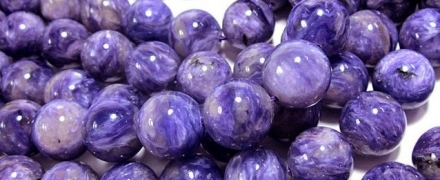open 10 am - 7 pm
laboratory is closed
Rare Gem - Charoite

Charoite is an ornamental stone with a lilac color of different saturation. Charoite belongs to the group of pyroxenes of the subclass of chain silicates. This mineral is characterized by impurities of numerous chemical elements such as barium, strontium, rare earth metals and manganese, with which scientists associate the lilac color of the mineral. There is only one charoite deposit in the world - the “Lilac Stone” on the border of Yakutia and the Irkutsk Region, where it was discovered for the first time in 1948. Charoite itself is found in the form of large blocks of rocks named after its charoite. Charoite rocks are characterized by numerous inclusions of minerals, for example, aegirine and feldspar, as well as more than 40 rare mineral species.
Due to its decorative qualities, as well as strength and ease of processing, charoite has found application in the jewelry industry. Various carvings, beads and much more are made from it. According to the physical properties and the severity of color, charoite is usually divided into 4 varieties, which further determine the scope of its application.
However, the number of charoite samples in the jewelry market is not so large and often the demand for this mineral exceeds supply. This is due to the fact that in Yakutia a ban on stone production of more than 100 tons per year was introduced in order to prevent the rapid depletion of charoite reserves.
В геммологической практике бывают весьма увлекательные случаи с диагностикой ювелирных вставок
Но помимо редкости цвета и высокой стоимости таких камней, многие розовые камни выделяются одной замечательной особенностью – они проявляют плеохроизм, то есть в зависимости от положения осмотра камня он может иметь дополнительные оттенки – оранжевый или пурпурный.
Currently, gemstones are produced by two fundamentally different technological methods - the High Pressure - High Temperature method (“HPHT”, High-pressure & High-temperature) and the Chemical Vapor Deposition (“CVD”, Chemical vapor deposition) method. The "HPHT" method is the most tested classical synthesis method, which can be used both carbon deposition on diamond from flux melts and catalytic reactions. In "CVD" synthesis, diamond growth occurs on a seed during carbon deposition mainly from a gaseous medium at relatively low temperatures and pressures.
Jewelry and precious stones are just such a category of goods, when buying which you need to pay attention to many criteria.
Sogdianite is a rather rare mineral and more often it can be found as a collection material (moreover, in systematic collections), and it is extremely rare in jewelry.






